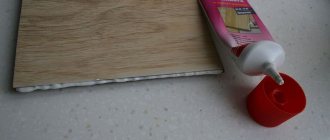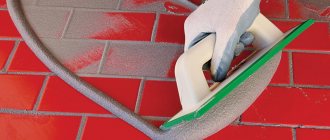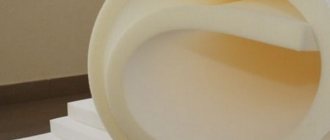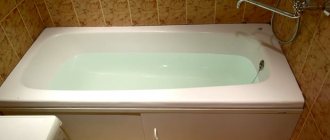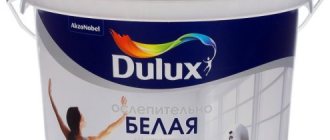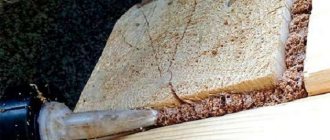All the numerous advantages of silicone sealants do not make this sealant ideal. In some cases, acrylic sealant will do the job better. Our article will tell you what the product is made from, what it comes in, and how it differs from its silicone “brother.”
Depending on what the composition becomes after use, all sealing agents are divided into three groups:
- Non-hardening compounds are sealants in the form of mastic, the most primitive of which is ordinary plasticine.
- Hardening compounds are silicone materials that harden as a result of a chemical reaction (vulcanization process).
- Drying compounds - such sealants become solid due to the gradual evaporation of the liquid.
This group includes acrylic sealants created on the basis of polymers. After application, the material only needs one day to dry. The one-component acrylic sealant is completely ready for use after opening the package. Other types of sealants are two-component formulations: their components must be pre-mixed before use.
Characteristics of acrylic sealant
A modern product containing acrylic is intended for moisture insulation and sealing of various joints. It is perfect for inexperienced users: it is easy to use, does not harden for a long time, thanks to which the position of the seam can be corrected. This composition is quite elastic, easily adapts to slight vibration, and after drying it can be plastered or painted.
Acrylic sealants are used to fill gaps and cracks: you just need to pour them inside and wait until dry. The material retains its characteristics indoors and is not afraid of temperature fluctuations or changes in humidity. Street conditions are less favorable for such compositions: in severe frost they (in the absence of special ingredients) become hard and sometimes crack.
Most acrylic sealants are waterproof, but they lose their properties when constantly exposed to moisture Source mirsmazok.ru
Technical specifications
The quality of acrylic sealants is assessed by an important indicator: elongation at the maximum possible stress. When a product is stretched while simultaneously subjected to excessive stress (more than the maximum permissible value), it will begin to become irreversibly deformed. As the number increases, the elasticity of the acrylate sealant increases. High-quality compounds have an indicator of 10% and above. When the mark on the package is 11%, they are already allowed to be used outdoors. Additionally, it is worth noting the following characteristics of acrylic-based sealants:
- permissible seam width is 0.6-5 cm, optimal thickness is correspondingly half that;
- operating temperature – from -20°С to +70°С;
- film formation time – 15 minutes;
- the period of adhesion of acrylic sealant to the base is no more than one hour;
- Drying time – 24 hours at humidity 50%, temperature 23°C;
- frost resistance (for a separate group) – more than five freeze-thaw cycles;
- break rate – 500%.
After curing, the acrylic sealant acquires optimal strength and resistance to deformation loads Source i.ytimg.com
Silicone sealants: composition features, advantages, scope of use
Silicone-based sealants are made from a rubber base. These compounds are used to completely seal cracks and spaces. Once cured, the coating will last for several years. No special action is needed to dry the product applied to the surface; it hardens well at room temperature.
The sealant contains a plasticizer, which imparts the property of increased elasticity: a primer, which is responsible for the adhesion of the newly applied sealant to the surface; amplifiers that contribute to the formation of a more durable material structure; vulcanizer - turns silicone sealant into a viscous mass.
Silicone sealant for various applications Source oboiman.ru
Varieties
Depending on the characteristics of operation and chemical composition, modern acrylic sealants are divided into groups.
Frost-resistant
The products are resistant to precipitation, aggressive external influences, and negative temperatures. They have significant elasticity and retain their integrity in the event of freezing. Most products are recommended to be used at -20°C and above, but there are more frost-resistant sealing mixtures. With their help, it is possible to process seams between logs and concrete slabs.
Frost-resistant acrylic sealant can be used for external repair and construction work in regions with very cold winters Source kraska.guru
Moisture resistant
They differ in their composite composition (silicon and rubber are added) and often contain other components that significantly improve the quality of the product. They are well suited for different purposes in rooms with high humidity (bathroom, kitchen). Compared to ordinary acrylic joint sealants, moisture-resistant products are better able to withstand temperature fluctuations and have fairly high adhesion to other building materials.
Moisture-resistant acrylic sealant is not intended for use in conditions of constant contact with water Source kraska.guru
Non-moisture resistant
Suitable only for interior work in conditions of normal or low humidity. They are often used when performing minor repairs, gluing baguettes and baseboards. Such products are recommended for use on concrete, brick, and wooden surfaces.
Non-moisture-resistant acrylic sealant is intended for rooms with normal humidity, is highly durable and resistant to fading Source elnik.com.ua
What it is?
Acrylic, or more precisely, polymethylacrylate in an aqueous dispersion is considered one of the simplest plastics and serves as the basis for acrylic sealant. In addition, there are thickeners (provide the desired consistency of the composition), fillers and plasticizers (thanks to their presence, the specified characteristics of the sealant are achieved). When some of them are combined, abundant foam is formed, to eliminate which manufacturers are forced to add defoamers. In addition, the composition contains surfactants (surfactants) and antiseptics, as well as an ammonia solution.
A special feature of acrylic sealant is that it contains water, which begins to evaporate after application. After the evaporation process is completely completed, the seam polymerizes and hardens.
Acrylic based sealant is designed to fill small cracks and gaps. However, most acrylic fillers are intended for indoor use. The slight changes in temperature and humidity inherent in rooms are not dangerous for the sealant, which cannot be said about the effects of negative temperatures. In this case, the seam becomes excessively hard and loses elasticity, which, in turn, leads to cracking. However, today on the construction market you can find modifications that can be used at temperatures of -20... +70 degrees.
The seam formed is characterized by elasticity and resistance to vibration and mechanical loads. The standard composition is available in a white or transparent version; after hardening, the surface can be plastered or painted. Some brands produce colored sealants, including ones that imitate various types of wood. Such compositions are indispensable in cases where it is necessary to create an invisible seam, indistinguishable in shade from the surfaces that it joins.
The form of release of the composition is small tubes (they are convenient to use for a small amount of work, for small cracks, the sealant is squeezed out immediately from the tube into the gap), tubes or cartridges (implies the use of a mounting gun) or a plastic bucket (it is profitable to buy it for large areas, the seams are filled using a spatula).
Color variety
You can often see white or colorless acrylic sealants in hardware stores. They are extremely popular among users because they fit perfectly with various plumbing fixtures and tiles. It is important to note that transparent compounds are hardly noticeable on treated surfaces. If you want to choose a sealing material that matches the color of the base, you need to buy a pigmented product of the desired color. There are also products in wood shades: oak, walnut, cherry, wenge and others.
A wide range of colors of acrylic sealants for wood makes it easy to choose the material that matches the color when processing any base. Source st3.stblizko.ru
What to look for when choosing a sealant?
In order not to make a mistake when choosing a sealant, you should pay attention to a number of factors. These include:
- compatibility of the sealant with the material of the surface you plan to seal;
- hardening time, permissible temperature limits;
- colorability;
- price;
- lifetime;
- composition and safety.
When choosing a sealed material, you need to determine the environmental conditions where the work is planned to be carried out. It is impossible to say unequivocally which sealant is better, silicone or acrylic. It all depends on the specific task and conditions of use. Decide what kind of work we are talking about - internal or external, what temperatures the material must withstand, what operational requirements you have, whether you plan to paint the surface after insulation.
There are also certain differences in the scope of application of sealants. For example, silicone is suitable for processing homogeneous surfaces (tiles, glass). Acrylic sealant, due to its texture, is capable of filling porous surfaces. For example, it could be concrete bases or wood. There are many more color variations for acrylic sealants. Due to this, it is easy to choose a color scheme and create a unified style for the interior and exterior.
According to performance characteristics, the service life of silicone is 20 years or more. With acrylic materials it is a little less so. When refinishing is needed, it is easy to determine by the external condition of the surface. As soon as cracks appear, get ready to renew.
Advantages and disadvantages of acrylic sealants
Using acrylic in repair work has a number of advantages. The main advantages of products containing it are:
- affordable price;
- wide choose;
- easy to use;
- the ability to correct defects;
- environmental friendliness;
- fire safety;
- do not turn yellow after a while;
- high adhesion to other building materials;
- Painting, puttying, mechanical processing of the seam is allowed;
- good vapor permeability;
- UV resistance;
- the ability to update damaged areas.
The main disadvantage of acrylic sealant is its intolerance to frequent contact with water. Being in a very humid environment, it gradually dissolves, and the seam accordingly deteriorates. Moisture-resistant materials can come into contact with moisture only after final drying. But with constant exposure to liquid, they lose their characteristics over time.
Vapor permeability is an important characteristic of acrylic sealant, which does not allow moisture to accumulate indoors Source omega-gc.ru
Second – ZIGGER
A German company that has been producing and selling its own products for more than 20 years. It enjoys enormous popularity on the Russian market due to its high quality and certified products.
It is worth noting that the polyurethane foam and sealants of this company occupy leading positions in the construction market. One of the reasons for this demand is our own production and a strict approach to each technological stage in the manufacturing process.
Regarding the cost, it is higher than that of the first contender. But at the same time, the middle price segment is offset by the highest quality of the material.
Among the most popular, it is worth noting the following products:
- one-component sealant in the form of a 310 ml cartridge - excellent for treating laminate and other types of flooring, including parquet. There is a wide variety of colors to suit individual interior features;
- a special construction sealant made from a multi-component base - excellent for sealing seams, joints, and significant cracks. Available in two colors: white and transparent.
It is not without its drawbacks, namely susceptibility to fungi and mold. They are caused by specific features of the internal structure of acrylic itself, and not by a negligent attitude towards production.
Where are they used?
Acrylic sealants do not contain solvents or harmful components, which is why they are best suited for interior work. Moreover, they can be applied in a closed room. There is no need to use protective equipment.
Acrylate sealants are often used for:
- sealing joints between beams and logs;
- filling joints between concrete elements;
- sealing the places of contact of individual elements with walls;
- replacing construction adhesive (for example, when attaching skirting boards to shelves);
- gluing fillets, baguettes, as well as high-quality sealing of seams between the latter and the base.
Advice! Acrylic sealant can be used for installing ceiling tiles and filling gaps.
Acrylic sealant is often used to seal the places where individual objects come into contact with walls Source gidpokraske.ru
Preparing surfaces for sealant
Using silicone sealant is very easy. But first it is necessary to carry out preparatory work in the places where it will be used. Surface preparation consists of three stages:
- cleaning joints and seams in the bathroom from dirt and dust - you can use a vacuum cleaner for this purpose;
- degreasing surfaces intended for sealing with sealant - to do this, wipe the cleaned seams with acetone or alcohol;
- drying the work surface - wipe it dry or do it with a hair dryer.
Features of application
The process of applying sealing material does not require special knowledge or tools. You just need to properly prepare the surface of the base: clean it from the accumulation of dirt, grease, and all kinds of old coatings, then dry it thoroughly. When you need to form a wide seam, you must purchase a sealant (for example, polyethylene cord) in advance. It will minimize the thermal conductivity of the connection, make it more reliable, and also significantly reduce material consumption (up to 70%).
Acrylic sealant can be applied without using gloves (it is harmless to the skin). However, it cannot be diluted with any liquid (including solvents). This will significantly reduce the quality characteristics of the mixture and lead to cracking of the seam.
You can apply the composition with a special gun: it is easy to insert cartridges and tubes into it. It is better to spread the sealing agent from a bucket with a narrow spatula; from a tube, squeeze it out in portions onto the required area.
After applying the acrylic sealant, it can be given the desired shape within another quarter of an hour. After the specified time, a polymer film begins to form, so repairing the seam will be difficult and impractical. The hardening of such material continues for a day; at a low temperature, the process is delayed for several more hours.
Applying a new layer of sealant
You can apply a new layer of sealant to a degreased (just wipe the surface with alcohol) and dried surface (a hairdryer will help you here). Use a special sealant for plumbing fixtures, preferably a fungicidal one, to avoid mold.
| Modern plumbing silicone sealants can be applied even to a damp surface. | |
| Some sealants can even be painted. |
| 1. Carefully cut off the tip of the canister containing the new sealant. | |
| 2. Insert the sealant bottle into a special mounting gun. | |
| 3. Carefully, in an even layer, apply a thin layer of sealant to the joint. | |
| 4. Release the pressure on the gun by pressing the lever on the back of the gun - this will stop the pressure of the piston on the bottom of the bottle and the flow of sealant will be interrupted. | |
| 5. Wet your finger with dishwashing liquid. | |
| 6. Apply this liquid to the sealant with your finger. |
As a rule, sealant is applied using a balloon and a mounting gun, but special small tube-syringes are much easier to use.
Consumption of funds
The required amount of acrylic sealant depends on the size of the future seam. In order to calculate it, you should multiply the depth and width of the gap. The result will be an approximate volume of material: it will show the required weight of the product (in grams) per 1 meter.
In the case where the joint is triangular in shape (instead of the usual rectangular), the final value should be divided by two. As practice shows, for 10 m of medium-thick seams, 250 g of sealing compound is sufficient.
Removing traces
It often happens that acrylic sealant accidentally gets on different surfaces. If it has not yet hardened, it is easy to remove. To do this, you need to thoroughly wash the base with soapy water.
Removing hardened material requires the use of a razor or sharp knife. Cut off the product layer by layer and very carefully so as not to damage the affected object. Residues should be rubbed off with fine sandpaper, steel wool or pumice. From delicate surfaces, such a composition is carefully removed with a wooden scraper. After finishing work, wash the cleaned base with a gentle detergent and then dry it.
Fresh traces of acrylic sealant can be easily washed off with water or a gentle detergent Source kraska.guru
How to choose a sealant
Usually in stores you can find universal sealing agents, as well as separately for windows and doors. In reality, the difference between them is minimal.
When processing smooth surfaces, it is important to additionally take the following measures: apply a special primer with abrasive particles to the base or walk over it with sandpaper. As a rule, such preparatory procedures are applied to various types of plastic.
Acrylic sealant is suitable for application to window structures: after final drying, it can be coated with suitable paint.
When purchasing a sealant for the kitchen or bathroom, it is necessary to take into account its resistance to moisture and the presence of fungicides in the composition.
When sealing joints in aquariums and shower stalls, it is recommended to use a sealant containing silicone.
In order to seal stoves, fireplaces, and other heating structures, it is better to purchase silicone or silicate compounds that are resistant to the influence of excessively high temperatures.
Popular brands
There are different sealants in stores, the most popular are the following compositions:
- “Universal” from Novbytkhim. An inexpensive product based on acrylate dispersion and mineral filler. After drying, it forms a moisture-resistant, rubber-like white seam that does not turn yellow over time. The sealant is non-toxic and can withstand temperatures of –30…+70 degrees. Designed for repair work indoors and outdoors.
- Zigger Acryl. Plastic, elastic means for compacting various substrates. Includes a freezing point depressant additive. It is thixotropic and can be applied to vertical bases and ceilings.
- "Moment Acrylic Universal". It is used for strengthening and sealing cracks and crevices in windows, for sealing joints between plumbing fixtures and floors and walls. Can be applied to the junctions of metal sinks and walls, countertops in the kitchen. Retains properties at temperatures of –50...+150 degrees, is neutral with respect to alkalis, oils, and remains durable for several years.
- Belinka Beldom Acryl. Acrylate sealant that is suitable for all building materials. Sufficiently elastic, withstands deformation within 5–10%. Does not wear out, is resistant to sunlight and weathering.
- Loctite PL-S50. Universal frost-resistant composition based on acrylic water dispersion. Designed to strengthen weak joints between concrete, brick, wood, plaster, and ceramics. Ideal for grouting cracked surfaces. Suitable for painting and plastering.
- Makroflex FA. Freeze and thaw resistant sealant. Suitable for external and internal work. The seam can be painted an hour after drying. Can be used for all types of seams with slight deformation and stretching.
- PENOSIL Premium Acrylic Sealant. A universal water-based acrylic composition used for filling joints and cracks in low-moving joints. It is odorless, easy to apply, and after drying it can be sanded and coated with paint or varnish. It is quite moisture resistant and can easily withstand contact with water 5 hours after use.
There are other acrylic-based sealants in construction stores: Titan, Krass, Master Tex, Pufas, Kim Tek and others. There is no need to save money and buy the cheapest composition. Products from well-known brands are of consistently high quality and highly effective. Working with acrylic sealants is easy and convenient; they will become reliable helpers in the home and on construction sites.
Differences between acrylate sealant and silicone
Sealing agents containing acrylic or silicone vary in properties and methods of use:
- After final hardening, acrylic seams can be painted in various colors with any water-based acrylate or latex paint. If necessary, treated areas can be easily restored and locally updated. The coloring composition does not adhere well to the silicone base.
- Acrylic sealant can be processed using mechanical methods: drilling, grinding. Silicone in the event of such an impact can completely separate, damaging the connection.
- The elasticity of acrylic is lower than that of silicone. Materials based on the latter are more plastic, give minimal shrinkage, and stretch well (without damage).
- Acrylic sealant is vapor-permeable, silicone is airtight. Therefore, the first does not have a negative effect on the microclimate inside the room.
- The moisture resistance of acrylic is significantly lower than silicone, a completely waterproof material that resembles rubber in its properties. Acrylate products are water-based, so they are subject to gradual dissolution.
- Acrylates are characterized by significant adhesion to porous building materials and are excellent for wooden and concrete bases. On the eve of sealing, smooth surfaces must be sanded to improve the quality of adhesion.
- Regular acrylic sealant costs less than silicone. Typically the difference is about 40%.
- The color range of acrylate products is significantly richer. If necessary, it is possible to select a suitable material of any color, including various types of wood. Silicone compounds are produced only in white, grayish, black, and red colors.
- Silicone lasts up to twenty years. Acrylic begins to lose its properties earlier; after a while it can dry out.
- Acrylates are environmentally friendly: safe for human health and do not harm nature. Silicone sealants made with acids emit an unpleasant odor, which limits their use.
Acrylic joint sealant is best suited for application indoors where the humidity level does not exceed normal values, provided there is no contact with liquid. This product is considered indispensable when the seam is planned to be painted. It is often used to eliminate cracks in window or door structures and seal plumbing fixtures. Silicone products are suitable for external use, bathrooms, sealing the walls of aquariums, and other items in contact with water. However, they cannot be used for processing concrete, stones, and metal bases.
Perm News
Silicone sealant on the side of a bathtub or sink does not last forever, so its condition must be constantly monitored. Otherwise, fungus and mold will be your neighbors.
Even if you are not going to renovate the bathroom, inspect the sealing seams. You may find traces of developing fungus or mold on the silicone. Over time, the sealant may darken, losing its attractive appearance. In this case, it is better to get rid of the old silicone and apply a new sealing compound. There are no difficulties in this work, but we will tell you how to do it easier and in accordance with existing rules.
What to pay attention to
In rooms where humidity is high (and in apartments this is the bathroom and kitchen), fungus and mold like to appear in the area of the seams between the tiles. To prevent this from happening, choose grout with fungicidal additives. We must put science at our service. The sides of the shower stall (tray), sinks, bathtubs, and other places where water flows down the walls or does not have time to quickly evaporate are also at risk. This is an ideal environment for mold. It appears in the form of dark (sometimes black) spots of small size. Many people mistake these stains for dirt, but they are mold.
We remove the sealant mechanically
The optimal technology involves removing the main old sealing layer mechanically, and the remainder using special chemicals. Silicone is strong, so removing it is not an easy task. Thorough cleaning is difficult to guarantee. Well, the eyes are afraid, but the hands are doing it. Of all the available tools in the house, residents most often use a razor blade, screwdriver or kitchen knife. But these household items do not provide high-quality results.
It is much more effective to purchase a special scraper or knife in the store to remove the sealing layer. Manufacturers are quite skilled in this matter. Some of them, meeting consumers halfway, produce sets of knives with attachments of various shapes made of plastic. Having removed the old sealing layer with such a knife, you put a nozzle on it - and in your hands you no longer have a knife, but a spatula, which is very convenient for applying a neat, even layer of new silicone sealant.
Removing sealant chemically
A more reliable and simpler method is the use of a mechanical method in conjunction with a chemical silicone cleaner. Special chemicals act sparingly, eliminating scratches and chips from sanitary fixtures and tiles. At the same time, the remnants of the old sealant are carefully removed. Hands will remain intact, which are not so uncommonly injured during mechanical cleaning. There are many special chemicals on sale. They have different names, for example, Soudal silicone remover, Sili-kill silicone solvent, Titeseal silicone cleaner and Tytan. But no matter what product you purchase: Penta-840, JVR Refinish Silicon Stop or Dow Corning OS-2, they all have the same goal - to help you remove the old layer of sealant.
If the budget does not allow you to use the listed drugs, time-tested folk methods are also suitable. To do this you will need gasoline or white spirit. Wear a respirator. The room must be ventilated. In order not to waste time, it is better to first remove the accessible layer of old sealant mechanically. Then apply white spirit or gasoline to the remaining sealant. Depending on the composition of the sealant, it will take from 1 to 8 hours to dissolve, so the cleaner will have to be reapplied periodically. When the silicone has dissolved, it is removed with a wooden (plastic) spatula or cloth so as not to scratch the surface.
Applying a new layer
Before applying the sealant, the surface is thoroughly cleaned of dirt and dust, degreased with white spirit, acetone or alcohol. Next, you must decide: apply a new layer immediately or first protect the wall and sanitary fixture in the seam area with electrical tape, tape or masking tape. Your main task is to obtain an even, high-quality sealing layer after pressing in the silicone and removing its excess. Now about how to smooth out the sealant. You can also do this with your finger, which, as many people know, is very sensitive to the material. Or you can buy a special set of spatulas designed to work with silicone sealants.
These tools differ in shape, different edge angles, and the thickness of the working planes. Special attachments are also sold that easily fit onto a tube of sealant, allowing you to apply and level the sealant layer in just one pass without much effort, which is very convenient. Now you know how to properly remove the old layer of sealant and apply a new one in its place. We are sure that everything will work out for you, and the bathtub or sink will again shine with its pristine whiteness.
